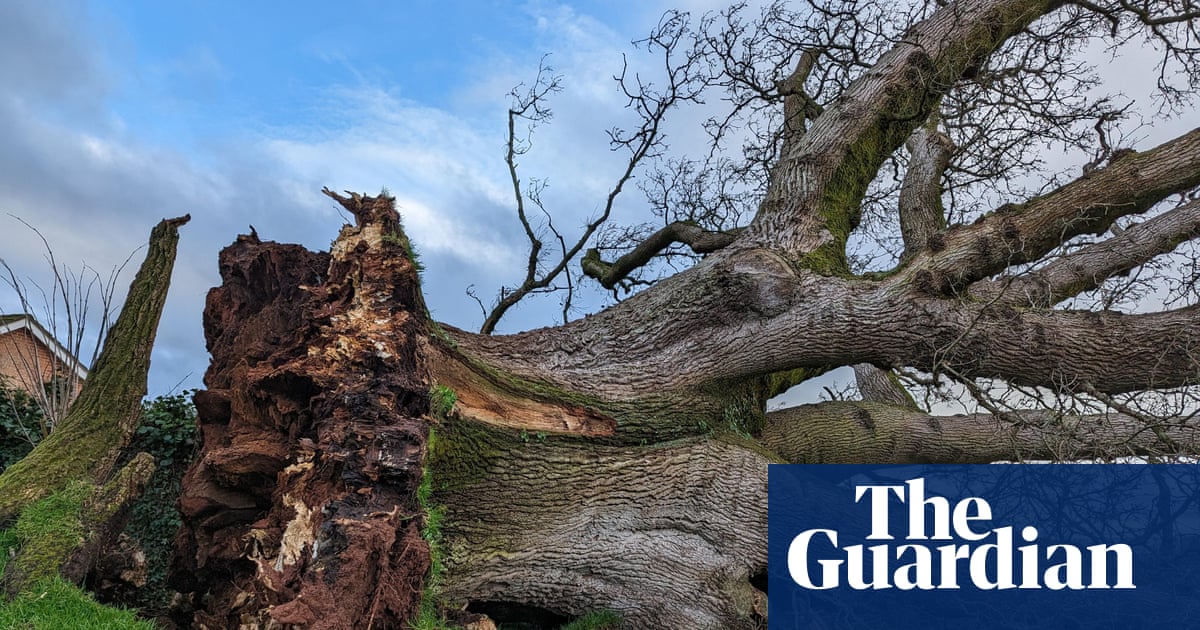
Since the 15th century, perhaps even longer, Broad Oak has been part of the Silverton landscape. Residents of the Devon village, one of the oldest in the south-west of England, have met beneath the tree’s mighty boughs clambered into the canopy, taken a few moments of peace in its shade. Theatre companies have borrowed it for a backdrop; people in need of comfort have hugged it; the primary school uses its image as its badge.
Now young and old are mourning its loss after the great tree fell – on a calm, sunny day rather than a stormy one – and the village is working out what to do with the remains of the oak, now crumpled across the recreation ground.
So many spoke of a feeling of bereavement. “It has been part of villagers’ childhoods, a part of the village scenery, a landmark meeting place for kids,” said Adrian Ryder. “But mostly just an awesome natural beauty that was living and breathing for so long in the village. It is such a shame that after circa 700 years it laid itself to rest – the stories it could tell.”
David Wright, who saw the tree fall at 12.30pm on 25 January, said: “I was sitting with a coffee looking out of the window when movement caught my eye. The oak tree was slowly tipping over. It seemed so slow it was surreal. Our first thought was to run to the tree to make sure there was nobody hurt, calling out then looking under the remains to see if anyone was visible. Thankfully only fences, paths and turf was destroyed.”
It could have been an even sadder story if Jan Ross, who lives closest to the tree, had not decided to pop down to the village shop for a copy of her newspaper (the Guardian, as it happens) on the day it fell.
“As I emerged from the store, I received a phone call from a neighbour telling me the oak had come down,” said Ross. “One of the large limbs of the tree crashed along the end of my garden demolishing the sturdy wooden fence. Ten minutes before the tree came down I was doing some garden tidying next to the fence and checking on the progress of spring bulbs. I could have been under its boughs.”
She added: “I have been a daily reader for over 50 years and it may have saved my life. We are all sad but even 700- to 800-year-old trees do come to the end of their life and we must make good use of what they leave us.”
It was standing-room only at the community hall on Monday evening as more than 50 residents gathered to try to decide what to do now. They were told workers with a crane would be on site in the coming days to make the tree safe.
The villagers heard that arboriculturists were keen to work on the remains to help with dating of the tree and to examine how it had been affected by the climate emergency. There was talk of how best to maximise the chances of hanging on to some of the precious, complex ecosystems that such a tree held.
People wanted to make sure some solid commemoration remained for future inhabitants. Slices of the trunk may be put on display. Some wanted a big branch left for children to play on and asked if larger pieces of the wood could be turned into public furniture and smaller ones into coasters or beer mats.
There was also enthusiasm for more tree planting in the community and a commitment to support wildlife and the environment with perhaps an annual tree planting on the anniversary of the fall. The hopeful wondered if a new tree could grow from the remains and a map of trees grown from Broad Oak’s acorns is being mooted.
Nikki Shaw shared pictures of the tree that could give clues as to why it came down and illustrated its rich biodiversity. One shows a sheared limb that fell in the opposite direction to the trunk, and appears to be rotten.
“It may have unbalanced the tree,” she said. Another was of five types of fungi on one branch, including oak crust and witches’ butter. A third was of a knopper gall that forms around acorns after a tiny wasp inoculates embryonic acorn buds with her eggs. “It is possibly the reason we have so few of its offspring around. Acorns have been hard to find some years since the 80s.”
It is not just current residents who are dealing with the loss. James Carroll, who previously lived in the village, said: “There are a good few former residents I have been in touch with around the country who are equally upset. Some were in tears. For many it’s like a family bereavement. For many of us who grew up in Silverton its was a part of our childhood and a sign of stability and permanence.”
Anthony Richards, the director of the professional theatre company Common Players, said the group had toured three versions of Robin Hood to the oak tree in the past 30 years. “The last, in 2001, was called The Tuck Inn and involved a community feast. Our cast have been mourning its passing. It was quite an inspiration to us.”
A poetic tribute from Olivia Kennard, who lives locally, was posted on the village’s Facebook page: “That wonderful tree was gentle to the last, just lying down quietly with the minimum of fuss and damage. I salute you.”












